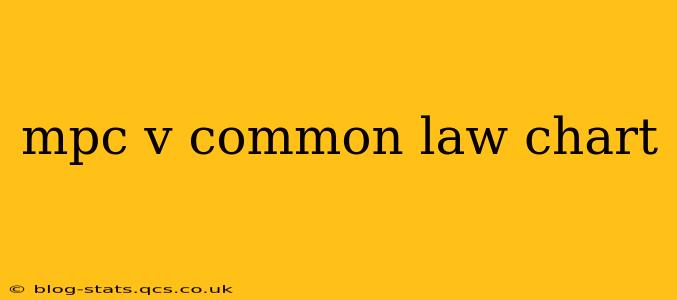Understanding the differences between the Model Penal Code (MPC) and common law approaches to criminal law is crucial for legal professionals and students alike. This article provides a comprehensive comparison, addressing common queries and offering insightful analysis. While a simple chart can highlight key distinctions, a deeper understanding requires examining specific elements within the context of each system.
What is the Model Penal Code (MPC)?
The MPC, drafted by the American Law Institute (ALI) in the late 1950s and early 1960s, isn't law itself. Instead, it's a proposed set of criminal statutes designed to standardize and improve criminal law across the United States. Many states have adopted portions of the MPC, resulting in a blend of MPC principles and traditional common law approaches.
What is Common Law?
Common law is judge-made law developed through judicial precedent. It's a system based on interpreting and applying past legal decisions to current cases. This leads to a more organic evolution of criminal law, varying significantly from jurisdiction to jurisdiction.
Key Differences: A Comparative Chart
| Feature | Model Penal Code (MPC) | Common Law |
|---|---|---|
| Source | Statutory (Proposed, not mandatory) | Judicial decisions, precedents |
| Structure | Codified, organized, systematic | Evolved organically, less consistent |
| Mens Rea | Specific definitions of mental states (purposely, knowingly, recklessly, negligently) | More flexible, relying on terms like "malice aforethought," with varied interpretations |
| Actus Reus | Clear articulation of required conduct | Can be more vague, relying on case-specific interpretations |
| Defenses | Specific defenses codified, often with clearer standards | Defenses vary widely, developed through case law |
| Homicide | Detailed grading of homicide offenses | More nuanced based on individual case facts and precedent |
| Theft Offenses | Consolidates theft crimes (larceny, embezzlement, false pretenses) into a single theft offense | Separate theft offenses with varying elements |
| Inchoate Crimes | Clearly defines attempt, conspiracy, and solicitation | More varied definitions and elements across jurisdictions |
Frequently Asked Questions (FAQs)
What are the major differences in the approach to mens rea under MPC and common law?
The MPC significantly improves upon the vagueness often found in common law definitions of mental states. The MPC uses four specific mental states: purposely, knowingly, recklessly, and negligently. This provides clarity and consistency lacking in common law's reliance on terms like "malice aforethought," which has varied interpretations across different jurisdictions and time periods.
How does the MPC handle the various theft offenses compared to common law?
Common law distinguishes between larceny, embezzlement, false pretenses, and other related crimes. The MPC simplifies this by consolidating many theft offenses into a single crime of theft, focusing on the unauthorized taking or exercise of control over another's property. This streamlining eliminates the often-confusing distinctions between similar crimes under common law.
Which system is more predictable, MPC or common law?
The MPC, with its codified and organized structure, provides greater predictability and consistency than common law. While not all jurisdictions adopt the MPC entirely, it offers a more standardized framework, helping reduce ambiguity and jurisdictional discrepancies in criminal law. Common law, however, can be more adaptable to changing societal norms and new types of crime, but this adaptability comes at the cost of potential inconsistency.
How do the approaches to homicide differ?
Both systems recognize different degrees of homicide, but the MPC generally provides a more structured approach. The MPC typically classifies homicide into murder, manslaughter, and negligent homicide, providing specific elements for each. Common law often relies on distinctions based on "malice aforethought," which can be interpreted differently, resulting in less consistency across jurisdictions.
Which system is more flexible and adaptable?
Common law, through judicial interpretation and precedent, exhibits greater flexibility in adapting to new circumstances and evolving social norms. The MPC, being a codified system, requires legislative action for changes, making it less readily adaptable to rapidly evolving legal landscapes. However, the MPC's structure allows for more straightforward interpretation and application in many cases.
Conclusion:
Both the MPC and common law approaches have strengths and weaknesses. The MPC promotes clarity, consistency, and predictability through its codified structure and precise definitions. Common law, while less consistent, offers greater flexibility and adaptability to social and technological changes. Understanding the fundamental differences between these two systems is essential for navigating the complexities of criminal law in the United States.
